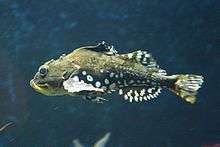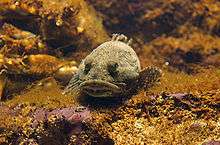Myoxocephalus scorpius
Myoxocephalus scorpius, typically known as the shorthorn sculpin or bull-rout, is a species of fish in the family Cottidae. It is a demersal species of the Northern Atlantic and adjacent subarctic and Arctic seas.[1][2][3] The species has many English names that are used less frequently or in small parts of its range, including Arctic sculpin, daddy sculpin, European sculpin, father-lasher, goat sculpin, Greenland sculpin, guffy, horny whore, pig-fish, scully, scummy, short-spined sea scorpion and warty sculpin.[4]
| Myoxocephalus scorpius | |
|---|---|
 | |
 | |
| Scientific classification | |
| Kingdom: | |
| Phylum: | |
| Class: | |
| Order: | |
| Family: | |
| Genus: | |
| Species: | M. scorpius |
| Binomial name | |
| Myoxocephalus scorpius | |
| Synonyms | |
| |
Appearance
It reaches maturity at 15–30 cm (6–12 in) in length and specimens from the Arctic and subarctic, which grow to the largest size, can reach up to 60 cm (24 in). The fish has a squat appearance, a large spiny head and a tapering body. It is a mottled grey-brown in colour but can be darker, including black as base coloring. It has a large mouth and spiny gill covers.[2]
The shorthorn sculpin is not venomous, but it can be mistaken for similar looking venomous fishes, notably scorpionfish.[5]
Habitat and behavior
The shorthorn sculpin is found among seaweed or on rocky bottoms with mud or sand from 0 to 451 m (0–1,480 ft).[2] Although primarily a marine species, it also occurs in brackish waters like the Baltic Sea.[1] Like some other coldwater fish, it has antifreeze proteins, which allow it to survive at temperatures around or slightly below freezing.[6][7]
They feed on a wide range of demersal and benthic fishes and crustaceans.[8]
The shorthorn sculpin spawns in December through March, the eggs being laid on between rocks in a clump protected by the male. They usually hatch in five weeks.
References
- Garcia, S. (2015). "Myoxocephalus scorpius". The IUCN Red List of Threatened Species. IUCN. 2015: e.T190210A18983059. Retrieved 24 May 2019.
- Froese, Rainer and Pauly, Daniel, eds. (2019). "Myoxocephalus scorpius" in FishBase. June 2019 version.
- Shorthorn Sculpin, Myoxocephalus scorpius Canada's Polar Life: Organisms. www.polarlife.ca
- FishBase: Common names of Myoxocephalus scorpius. Retrieved 1 June 2019.
- Horton, A. Terror of the Rock Pool. British Marine Life Study Society.
- Hew, C.L.; Fletcher, G.L.; Ananthanarayanan, V.S. (1980). Antifreeze proteins from the shorthorn sculpin, Myoxocephalus scorpius: isolation and characterization. Can J Biochem. 58(5): 377–383.
- Baardsnes, J.; Jelokhani-Niaraki, M.; Kondejewski, L.H.; Kuiper, M.J.; Kay, C.M.; Hodges, R.S.; Davies, P.L. (2001). Antifreeze protein from shorthorn sculpin: identification of the ice-binding surface. Protein Sci. 10(12): 2566–2576.
- The Pocket Guide to Saltwater Fishes of Britain and Europe
External links
- Photos of Myoxocephalus scorpius on Sealife Collection
| Wikimedia Commons has media related to Myoxocephalus scorpius. |
